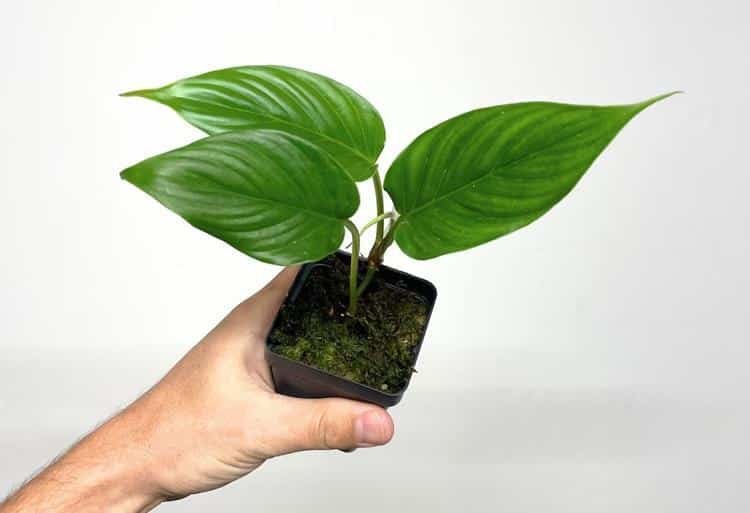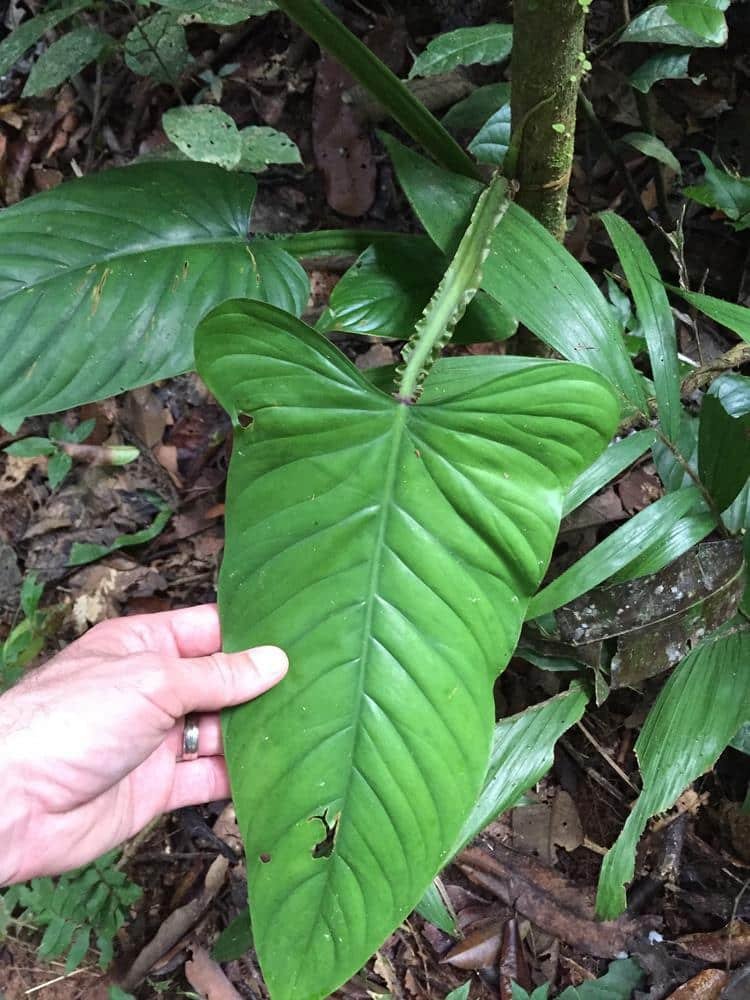The petioles with ruffled/wavy winged margins and rippled or quilted dark green leaves with gray-green variegations make Philodendron ernestii quite a charm. This rare climbing houseplant will give your home, office, patio, or hallway that breathtaking tropical vibe.
It is not hard to care for; ensure you grow it in a warm (55-80°F), humid (>40%) place with bright indirect light. Its soil should be rich in humus, airy, and well-drained, and you need to water it after the top few inches feel dry.
Discover everything about Philodendron ernestii, from appearance and description to care to any issues you may encounter. We will also give you prices and where to find them at the best prices.

About Philodendron ernestii
Philodendron ernestii Engl. is an accepted Philodendron species. It was first described/published by Adolf Engler (1844-1930), a German botanist, in 1905. He (Engler) named ernestii after Ernst Heinrich Georg Ule 1854-1915), a German botanist and plant collector.
- Scientific name: Philodendron ernestii
- Family: Araceae
- Native habitat: West South America to North Brazil, i.e., Bolivia, Peru, Ecuador, N. Brazil, and Colombia
- Care level: Easy or Low maintenance
- Propagation: Stem cutting in water/soil or air layering
- Toxicity: Mildly to moderately toxic to humans, dogs, cats, and other pets. Why? Because it has insoluble calcium oxalate
1. Growing habits, size, growth rate
Philodendron ernestii is an evergreen climbing hemiepiphyte. In its native habitat, it occurs in tropical moist, premontane wet, lower montane, and tropical wet forests, where it grows appressed to tree trunks.
If given optimum growing conditions and care, P. ernestii has a relatively fast growth rate. It can grow up to 23 feet in the wild and about 4 to 8 feet high at home. However, to be this tall and have those large, beautiful mature leaves, you need to give it a place to climb.
2. How to identify Philodendron ernestii
We will look at stems, juvenile and mature leaves, and flowers. However, this plant is unlikely to flower at home.
a). Stems
Mature plants will have pendent flowering stems, longer internodes, and thicker stems than juveniles.
These weakly glossy, medium green to dark olive green, yellow-green or brownish stems are warty and tuberculate and will have D-shaped, single or unribbed reddish or purplish-tinged, deciduous cataphylls.
b). Juvenile and mature leaves
Juvenile plants will have shorter (3.5-7.9 inches long) petioles and, in most cases, smaller (5.1-7.9 long by 2.4-3.1 inches wide) narrowly oval to constricted sagittate leaves.
On the other hand, mature Philodendron ernestii will have large (6.3-28.3 long by 2.4-22 inches wide, averaging at 16.2 by 8.3 inches ), rosette, oval sagittate to concave-oval, dark green leaves with gray-green variegations. These subleathery, semi-glossy have a flat to obtusely sunken midrib, paler below or, at times, purplish or red-edged.

Besides the leaf shape, to identify this plant, look at the anterior and posterior lobes. Anterior lobes have partly naked basal ribs and 6-9 basal veins, often branched, 1-3 free, others fused in groups of 2-3 but usually 2-3 and at varying points.
On the other hand, the anterior lobe has an acuminate apex and 7-9 primary lateral veins, often branched, with a paler or, at times, purplish underside.
Another easy-to-notice unique feature is that both basal and primary lateral veins may be obtuse to narrowly to deeply sunken quilted above, giving a rippled or wavy appearance. But they may, in some cases, be raised.
Lastly, these mature P. ernestii have long (7.9-25.6 inches), weakly glossy, medium green petioles, darker towards the margin and with violet-purple ring and wavy or ruffled winged margins (not always) that flare broadly ). These petioles are D-shaped or nearly triangular, broadly convex in the middle above and convex, rounded or abruptly flatted, and paler below
c). Flowers and fruits
Philodendron ernestii is unlikely to flower at home. However, in the wild, it will have one inflorescence per axil, rarely two, with a maroon peduncle, slightly constricted spathe, and spadix.
The spathe is white to medium green or dark violet purple, with the tube heavily tinged maroon or purple and may have short, raised, irregular lines on the outside, whitish or weakly reddish tinged on most of the inner surface to magenta or dark purple.
On the other hand, the spathe’s blade is whitish inside; on the outside, it is faintly magenta tinged and usually has maroon spots.
Lastly, these flowers will have berry-like, cream, or cream-orange infructescence.
Caring for Philodendron ernestii
Philodendron ernestii requires a warm, humid place with bright indirect light. Its soil should be airy, chunky, and rich in organic matter, and you should water it when the top few inches of the potting mix feel dry.
Here is a summary of care needs and growing conditions:
- USDA hardiness zone: 10-11, not frost hardy.
- Temperature: 55-80°F. Avoid cold drafts, sudden temperature changes, or places near heat sources.
- Humidity: Loves humidity, with the ideal being 60% or more. But can tolerate 40% or more. Buy a humidifier, have a pebble tray, mist your plant or use other ways to raise humidity if yours is low.
- Light: Bright, indirect light but can tolerate medium. Avoid direct sunlight as it will burn leaves and for low light, get grow lights.
- Soil: Grow it in a well-drained, aerated potting mix rich in organic matter. I use aroid mixes (see Etsy.com), or you can add perlite, coco coir, bark chips, and compost or worm castings to potting soil to make yours at home.
- Watering: Thoroughly water your ernestii when the potting mix feels dry up to the first knuckle of your finger or the soil moisture meter reads dry (3 or less for XLUX).
- Feeding: Feed once a month with a balanced, liquid houseplant fertilizer during growing months, starting with half recommended strength. However, non-balanced or slow-release formulas are still ok.
- Pruning: Regularly cut dead, damaged, or diseased leaves with sterilized gardening shears. You can also cut back some stems if it becomes too large during the growing months.
- Repotting: Repotting is after 1-2 years or if rootbound. Select a pot 2-3 inches wider in diameter.
- Support: Since it is a climber, give and train this plant on a moss pole, totem, trellis, etc.
Issues this plant may have
Some issues include pests and diseases, but they are uncommon indoors. Other issues are root rot (common if you overwater your plant or potting mix is heavy and doesn’t drain), drooping, leaf discoloration, and curling.
Common pests include spider mites, mealybugs, scale insects, aphids, and thrips. You can control them using insecticidal soaps, neem oil, or horticultural oil spray. However, drench the soil with 3% hydrogen peroxide if you have fungus gnats.
Diseases that affect this and other Philodendrons include the dasheen mosaic virus, southern blight, fungi, and bacterial leaf spots. Practice good sanitation and always isolate sick or new plants
Lastly, your plant drooping, leaves curling, having spots or turning yellow, black or brown, including brown edges and margin, is a sign of wrong growing conditions and improper care. However, it may be due to diseases, pests, or your plant being root bound.
Frequently asked questions
Yes. Philodendron ernestii is a rare and uncommon lovely houseplant. You will have to dig deep to find a vendor who has it even on popular online marketplace platforms or social media with plant vendors.
The average cost of Philodendron ernestii ranges from $30 to $100. Larger established plants will cost more, and smaller, unrooted ones or cuttings less.
Try Etsy.com, eBay, Facebook, and Instagram. You may be lucky to get a vendor near you. Also, try searching on any major search engines for more online vendors.
